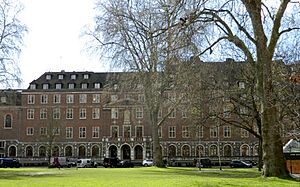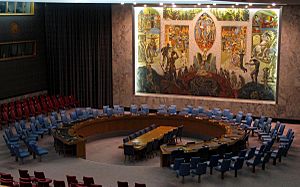United Nations Security Council facts for kids
Quick facts for kids  |
|
|---|---|
|
UN Security Council Chamber in New York City
|
|
| Org type | Principal organ |
| Status | Active |
| Headquarters | New York City, U.S. |
The United Nations Security Council (UNSC) is one of the six main parts of the United Nations (UN). Its most important job is to make sure there is peace and safety around the world. It also suggests new countries to join the UN and approves changes to the UN's main rulebook, the UN Charter.
The Security Council has the power to start peacekeeping missions, put international sanctions on countries, and even allow military action. It is the only UN group that can make rules that all member countries must follow.
Just like the UN itself, the Security Council was created after World War II. It was formed to fix the problems of an older group called the League of Nations, which had failed to keep world peace. The Security Council had its first meeting on January 17, 1946. For many years, it was hard for the Council to act because of the Cold War between the United States and the Soviet Union.
Even so, the Council did approve military actions in the Korean War and the Congo Crisis. It also sent peacekeepers to places like Cyprus and the Sinai Peninsula. After the Soviet Union broke apart, UN peacekeeping grew a lot. The Security Council approved big missions in places like Kuwait, Namibia, Cambodia, Bosnia and Herzegovina, and Rwanda.
The Security Council has fifteen members. Five of these are permanent members: China, France, Russia, the United Kingdom, and the United States. These countries were the main winners of World War II. Permanent members can say "no" (this is called a veto) to any important decision the Council tries to make. This means they can stop a resolution from passing.
The other ten members are chosen from different regions of the world for two-year terms. The country that leads the Council (the President) changes every month among its members.
Rules made by the Security Council are usually carried out by UN peacekeepers. These are military forces that member countries volunteer to provide. They are paid for separately from the main UN budget. As of November 2021, there were 12 peacekeeping missions with over 87,000 people from 121 countries. Their total yearly cost was about $6.3 billion.
Contents
How the Security Council Started
Why the UN Security Council Was Created
Before the UN, there were other groups and meetings that tried to stop fights between countries. For example, the International Committee of the Red Cross was formed, and the Hague Conventions of 1899 and 1907 set rules for war. After many lives were lost in World War I, the League of Nations was created to keep peace.
The League of Nations did solve some land disagreements. It also set up international systems for things like mail and air travel. Some of these ideas were later used by the UN. However, the League didn't include many major countries like the US, the Soviet Union, Germany, and Japan. It also failed to stop Japan's invasion of Manchuria in 1931 or Nazi Germany's actions that led to World War II.
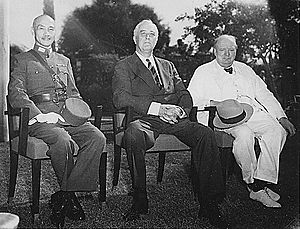
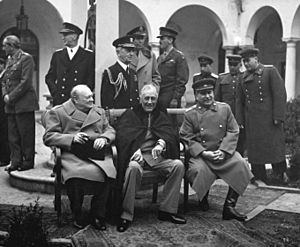
On New Year's Day in 1942, leaders from the US, UK, Soviet Union, and China signed a document called the United Nations Declaration. This was the first official use of the term "United Nations." By March 1945, 21 more countries had signed it. The four main Allied countries – the United States, the United Kingdom, the Soviet Union, and China – were called the "Four Policemen." They became the basis for the Security Council.
In 1944, these "Big Four" countries met at the Dumbarton Oaks Conference to plan the UN's structure. A big topic was who would be on the Security Council. France, China, the Soviet Union, the UK, and the US were chosen as the permanent members. The US wanted Brazil to be a sixth permanent member, but others disagreed.
The hardest part to agree on was the "veto" power for permanent members. The Soviet Union wanted each permanent country to be able to stop any discussion. The British thought countries shouldn't be able to veto decisions about problems they were involved in. At the Yalta Conference in February 1945, the US, UK, and Russia agreed that the "Big Five" could veto any action by the Council, but not stop discussions.
On April 25, 1945, the UN Conference on International Organization started in San Francisco. Fifty governments met to write the United Nations Charter. Some countries wanted to limit the veto power, but this idea was voted down because people feared the UN wouldn't be created if the big powers didn't get their veto.
The UN officially began on October 24, 1945, when the Charter was approved. The Security Council had its first meeting on January 17, 1946, in London.
The Security Council During the Cold War
In its early years, the Security Council often struggled to act because of the Cold War between the US and the Soviet Union. They often disagreed, which stopped the Council from making decisions. One important exception was in 1950, when the Council allowed a US-led group to stop North Korea's invasion of South Korea. This happened because the Soviet Union was not present at the meeting.
In 1956, the first UN peacekeeping force was created to help end the Suez Crisis. However, the UN couldn't stop the Soviet Union from invading Hungary around the same time. The Cold War also stopped the Security Council's Military Staff Committee from working. This committee was supposed to manage UN forces.
In 1960, the UN sent a large military force, the United Nations Operation in the Congo (UNOC), to bring peace to the Congo. But in bigger conflicts like the Cuban Missile Crisis or the Vietnam War, the Security Council was often bypassed. Instead, the US and Soviet Union talked directly. The Council focused on smaller conflicts, sending peacekeepers to West New Guinea in 1962 and Cyprus in 1964. The mission in Cyprus became one of the UN's longest-running peacekeeping efforts.
In 1971, communist China took over the seat on the Security Council that had been held by the Republic of China (Taiwan). This showed that the US's influence in the UN was changing. As more developing countries joined and the UN couldn't solve big conflicts like those in the Middle East or Vietnam, it started focusing more on helping countries develop and share cultures. By the 1970s, the UN spent much more on social and economic development than on peacekeeping.
The Security Council After the Cold War
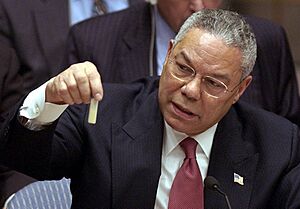
After the Cold War ended, UN peacekeeping grew a lot. The UN took on more missions in ten years than it had in the previous four decades. Between 1988 and 2000, the number of Security Council decisions more than doubled, and the peacekeeping budget increased by over ten times.
The UN helped end the Salvadoran Civil War, had a successful peacekeeping mission in Namibia, and oversaw fair elections in South Africa after apartheid and in Cambodia after the Khmer Rouge. In 1991, the Security Council quickly condemned Iraq's invasion of Kuwait and allowed a US-led group to push Iraq out.
However, the UN also faced tough challenges. In the early 1990s, there were many serious problems within countries, like in Haiti and the former Yugoslavia. The UN mission to Bosnia was criticized for not being able to stop ethnic cleansing. In 1994, the United Nations Assistance Mission for Rwanda failed to stop the Rwandan genocide because the Security Council couldn't decide what to do.
In the late 1990s, UN-approved actions became more varied. The UN mission in the Sierra Leone Civil War was helped by British forces. The 2001 invasion of Afghanistan was overseen by NATO but authorized by the UN. In 2003, the US invaded Iraq without a Security Council approval, which made people question the UN's power again.
In the same decade, the Security Council sent peacekeepers to help with crises like the War in Darfur in Sudan and the Kivu conflict in the Democratic Republic of Congo. In 2013, a review of the UN's actions during the end of the Sri Lankan civil war in 2009 found that the organization had "systemic failure."
In late 2014, Egypt suggested that the non-Proliferation Treaty (NPT) should include Israel and Iran. This was due to growing conflicts in the Middle East. All Security Council members have signed the NPT, and all permanent members have nuclear weapons.
What the Security Council Does
The UN's job in keeping international safety is explained in the UN Charter. The Charter allows the Security Council to:
- Look into any situation that threatens world peace.
- Suggest ways to solve disagreements peacefully.
- Ask other countries to stop economic ties, communications, or diplomatic relations with a country.
- Use military force or other means to make its decisions happen.
The Security Council also suggests who should be the new Secretary-General and recommends new countries to join the UN. Usually, the Security Council focuses on military safety. However, in 2000, US Ambassador Richard Holbrooke convinced the Council to pass a resolution about HIV/AIDS in Africa, which was a new type of issue for them.
Under Chapter VI of the Charter, the Security Council can "investigate any dispute, or any situation which might lead to international friction or give rise to a dispute." If a situation could threaten peace, the Council can "recommend appropriate procedures or methods of adjustment." These suggestions are usually not binding, meaning countries don't have to follow them.
Under Chapter VII, the Council has more power. It can decide what actions to take when there are "threats to the peace, breaches of the peace, or acts of aggression." In these cases, the Council can use armed force "to maintain or restore international peace and security." This was the legal reason for UN military actions in Korea in 1950, Iraq and Kuwait in 1991, and Libya in 2011. Decisions made under Chapter VII, like economic sanctions, are binding on UN members. The Security Council is the only UN group that can make binding decisions.
The Rome Statute of the International Criminal Court says that the Security Council can send cases to the International Criminal Court (ICC) even if the Court wouldn't normally have power over them. The Council first did this in March 2005, sending the situation in Darfur to the ICC. Sudan was not a member of the ICC, so the Council's referral was important. The Council did this again in February 2011 for the 2011 Libyan Civil War.
Security Council Resolution 1674, passed in 2006, says that the UN has a "responsibility to protect" people from very serious crimes like genocide, war crimes, ethnic cleansing, and crimes against humanity. This means the Security Council is committed to protecting civilians in armed conflicts.
Who Are the Members?
Permanent Members
The Security Council has five permanent members. These countries can veto any important decision, which means they can stop it from being approved. However, they cannot stop a discussion about an issue.
| Country | Regional group | Current state representation | Former state representation |
|---|---|---|---|
| Asia-Pacific | 1949–1971) |
||
| Western Europe and Others | Fourth Republic (1946–1958) |
||
| Eastern Europe | |||
| Western Europe and Others | and Northern Ireland |
N/A | |
| Western Europe and Others | N/A |
When the UN started in 1945, the five permanent members were the Republic of China, France, the Soviet Union, the United Kingdom, and the United States. There have been two big changes since then. China's seat was first held by the Nationalist Government (Republic of China). But in 1949, the Nationalists moved to Taiwan during the Chinese Civil War. The Chinese Communist Party took control of mainland China, which became the People's Republic of China. In 1971, the UN decided that the People's Republic was the true representative of China and gave it the Security Council seat.
After the dissolution of the Soviet Union in 1991, the Russian Federation took over the Soviet Union's spot on the Security Council.
These five permanent members were the winning countries in World War II. They have kept the strongest military forces in the world ever since. They spend the most money on defense each year. They are also the biggest sellers of weapons and are the only countries officially allowed to have nuclear weapons under the Nuclear Non-Proliferation Treaty.
What is the Veto Power?
Under Article 27 of the UN Charter, important Security Council decisions need at least nine out of fifteen votes to pass. If a permanent member votes "no" (uses its "veto"), the decision cannot be approved, even if it has enough votes. If a permanent member chooses not to vote (abstains), it usually doesn't count as a veto. However, all five permanent members must agree to change the UN Charter.
The veto power cannot be used to stop a discussion about an issue. Most vetoes have been used to block a candidate for Secretary-General or to stop a new country from joining the UN, not in major international security situations.
When the UN was being created, many smaller countries didn't like the idea of the veto power. But the five big powers (US, UK, China, France, and the Soviet Union) insisted on it. They said that if there was no veto, the UN would not be created at all.
As of 2012, 269 vetoes had been used. Russia (or the Soviet Union) used the veto 128 times, the US 89 times, the UK 32 times, France 18 times, and China 9 times. About two-thirds of Russia's vetoes happened in the first ten years of the Council. Between 1996 and 2012, the US used 13 vetoes, Russia 7, and China 5. France and the UK did not use their veto during this time.
An early veto by the Soviet Union in 1946 stopped a decision about French forces leaving Syria and Lebanon. This showed that permanent members could use the veto on issues not directly related to war. The Soviet Union also vetoed the admission of many countries to the UN, delaying their membership for years. The UK and France used the veto to avoid being criticized for their actions in the 1956 Suez Crisis. The US first used its veto in 1970. From 1985 to 1990, the US vetoed 27 decisions, mostly to block resolutions seen as against Israel.
Non-Permanent Members
Besides the five permanent members, the Security Council also has ten temporary members. These members hold their seats for two years and are chosen from different regions of the world. Non-permanent members can also be involved in global security discussions.
In its first twenty years, the Security Council had six non-permanent members. In 1965, this number was increased to ten.
These ten non-permanent members are elected by the United Nations General Assembly for two-year terms. Five new members are chosen each year. To be elected, a country needs at least two-thirds of all votes. Sometimes, this can lead to a long voting process if two countries are very close in votes. For example, in 1979, Cuba and Colombia had a standoff that lasted three months and 154 rounds of voting. They both eventually stepped aside for Mexico. A country that has just finished its term cannot be immediately re-elected.
The ten non-permanent seats are divided among different regional groups:
- African Group: 3 members
- Asia-Pacific Group: 2 members
- Latin America and the Caribbean Group: 2 members
- Western European and Others Group: 2 members
- Eastern European Group: 1 member
Usually, one of the seats for the Asia-Pacific or African Group is filled by a country from the Arab world.
The current elected members, and the regions they represent, are:
| Term | Africa | Asia-Pacific | Eastern Europe | Latin America and Caribbean |
Western Europe and Other |
|||||
|---|---|---|---|---|---|---|---|---|---|---|
| 2022 | ||||||||||
| 2023 | ||||||||||
| 2024 | ||||||||||
| 2025 | ||||||||||
| 2026 | ||||||||||
The President of the Security Council
The President of the Security Council is in charge of setting the meeting agenda, leading the meetings, and handling any crises. The President can also make official statements. The role of President rotates among all 15 members each month, following the English alphabetical order of the countries' names.
The countries that will hold the Presidency in 2025 are:
| Month | Country |
|---|---|
| January | |
| February | |
| March | |
| April | |
| May | |
| June | |
| July | |
| August | |
| September | |
| October | |
| November | |
| December |
Where the Security Council Meets

Unlike the General Assembly, the Security Council doesn't have set "sessions." Each member country must always have a representative ready at the UN Headquarters in New York City in case an emergency meeting is needed.
The Security Council usually meets in a special room in the United Nations Conference Building in New York City. Norway gifted this room, and it was designed by Norwegian architect Arnstein Arneberg. A mural by Norwegian artist Per Krohg (1952) shows a phoenix rising from ashes, symbolizing the world's new start after World War II.
The Security Council has also met in other cities like Nairobi, Kenya; Addis Ababa, Ethiopia; Panama City, Panama; and Geneva, Switzerland. In March 2010, the Council moved to a temporary place while its main room was being fixed up. The main room reopened on April 16, 2013. The representatives sit at a horseshoe-shaped table. The President sits in the middle, with the Secretary and Undersecretary next to them. Other representatives sit in alphabetical order. The seating changes each month when the presidency rotates.
Because meetings in the main Security Council Chamber are open to the public, countries sometimes use this to make their points, like by walking out.
Private Meetings and Discussions
Because the main Security Council Chamber is public, much of the Council's work happens in private "informal consultations."
In 1978, West Germany paid for a private conference room next to the main Chamber. This room became the main place for "informal consultations." In 1994, the French ambassador noted that these private meetings had become the usual way of working, while public meetings became rare and often just confirmed decisions already made in private. When Russia paid to renovate this room in 2013, the Russian ambassador called it "the most fascinating place in the entire diplomatic universe."
Only members of the Security Council are allowed in this private room. The press is not allowed, and other UN members cannot be invited. No official record is kept of these private talks. This allows countries to negotiate and make deals in secret without every word being written down. The privacy also helps delegates be more friendly with each other.
A permanent member can use a "pocket veto" during these private talks by saying they are against a decision. Since a veto would stop the decision anyway, the country that suggested it will usually not bring it to a public vote. By the time a decision reaches the main Security Council Chamber, it has already been discussed and changed in private. The public meeting is often just a formal approval of a decision already made. For example, Resolution 1373 was approved without public discussion in a meeting that lasted only five minutes.
The Security Council holds many more private consultations than public meetings. In 2012, it had 160 private consultations, 16 private meetings, and 9 public meetings. During crises, the Council still meets mostly in private, but it also holds more public meetings. After the Russo-Ukrainian War started in 2014, the Council went back to Cold War patterns, with Russia and Western countries arguing in front of cameras. In 2016, the Council held 150 consultations, 19 private meetings, and 68 public meetings.
UN Peacekeepers
After the Security Council approves it, the UN can send peacekeepers to areas where fighting has stopped or paused. Their job is to make sure peace agreements are followed and to stop fighting from starting again. Since the UN doesn't have its own army, member countries volunteer their soldiers. These soldiers are sometimes called "Blue Helmets" because of their special helmets. The peacekeeping force won the Nobel Peace Prize in 1988.
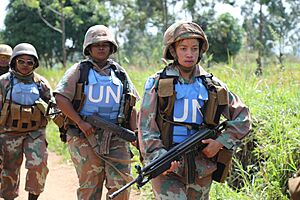
As of February 28, 2023, the UN had 86,903 uniformed and civilian staff in 12 peacekeeping missions. 121 countries provided military personnel. The largest mission was the United Nations Organization Stabilization Mission in the Democratic Republic of the Congo (MONUSCO), with 20,688 uniformed staff. The smallest, United Nations Military Observer Group in India and Pakistan (UNMOGIP), had 42 uniformed staff watching the ceasefire in Jammu and Kashmir. Peacekeepers with the United Nations Truce Supervision Organization (UNTSO) have been in the Middle East since 1948, making it the longest active peacekeeping mission.
The money for peacekeeping is separate from the main UN budget. For the year from July 1, 2021, to June 30, 2022, peacekeeping cost $6.38 billion. UN peacekeeping operations are paid for by member countries, with the five permanent Security Council members paying a larger share. This helps less-developed countries pay less.
This money pays for 10 of the 12 ongoing UN peacekeeping missions. It also helps with closing down the UN African Union Hybrid Operation in Darfur (UNAMID) and provides support for the African Union Mission in Somalia (AMISOM). The UN Truce Supervision Organisation (UNTSO) and the UN Military Observer Group in India and Pakistan (UNMOGIP) are paid for by the regular UN budget.
For the 2020–2021 budget, the top 10 countries that paid the most for UN peacekeeping were the US (27.89%), China (15.21%), Japan (8.56%), Germany (6.09%), the United Kingdom (5.79%), France (5.61%), Italy (3.30%), Russian Federation (3.04%), Canada (2.73%), and South Korea (2.26%).
Ideas for Changing the Security Council
People have been suggesting ways to change the Security Council since the UN Charter was written. As historian Paul Kennedy said, "Everyone agrees that the present structure is flawed. But consensus on how to fix it remains out of reach."
There have been talks about adding more permanent members. The countries that want permanent seats the most are Brazil, Germany, India, and Japan. Japan and Germany were the second and third largest funders of the UN for a long time (before China became second). Brazil and India send many troops to UN peacekeeping missions. These four countries are known as the G4 nations.
Italy, which is the UN's sixth-largest funder, leads a group called Uniting for Consensus. This group is against adding more permanent seats. Countries in this group include Canada, South Korea, Spain, and Pakistan. They suggest creating a new type of non-permanent seat that would last longer. They also talk about changing the veto power, from getting rid of it completely to only using it for very serious matters.
Former UN Secretary-General Kofi Annan asked experts to suggest ways to reform the UN by the end of 2004. One idea was to add five more permanent members. Most suggestions include Brazil, Germany, India, and Japan, plus one country from Africa (like Egypt, Nigeria, or South Africa), and/or one from the Arab League. On September 21, 2004, the G4 nations said they supported each other's claims for permanent status, along with two African countries. For this idea to pass, two-thirds of the General Assembly (128 votes) must agree.
The current permanent members have been slow to state their positions on reform. The United States strongly supports Japan becoming a permanent member and also supports India and a few more non-permanent members. The United Kingdom and France generally support the G4 idea, wanting more permanent and non-permanent members, including Germany, Brazil, India, and Japan, and more African countries. China supports more representation for developing countries but is firmly against Japan becoming a permanent member.
In 2017, it was reported that the G4 nations were willing to temporarily give up their veto power if they were given permanent UNSC seats. In September 2017, US Representatives Ami Bera and Frank Pallone introduced a resolution in the US House of Representatives to support India becoming a permanent member of the Security Council.
While discussions about adding individual countries continue, other ideas have been suggested to change the Security Council's structure. The Noble World Foundation (NWF) suggests that UNSC membership and veto power could go to groups of countries that share power, like the European Union (EU). This idea fits with how the UNSC already chooses non-permanent members based on regions. It aims to make the Council better at making decisions. The EU is a good example of such a group, especially since a 1964 court ruling said EU law is more important than national laws for its members. The NWF believes regional groups like the EU could become UN Security Council members without needing to change the UN Charter.
In 2025, at the 17th BRICS summit in Rio de Janeiro, Brazil’s outgoing BRICS president, President Luiz Inácio Lula da Silva, and India’s Prime Minister Narendra Modi both said they want their countries to become permanent members of the UNSC. Modi stressed that the UNSC needs to be reformed to be more believable and effective by including more countries from the Global South. Both leaders confirmed that reforming the UNSC will be a top goal for India when it leads BRICS in 2026.
Images for kids
See also
 In Spanish: Consejo de Seguridad de las Naciones Unidas para niños
In Spanish: Consejo de Seguridad de las Naciones Unidas para niños
- Reform of the United Nations
- Small Five Group, a group formed to improve the working methods of the Security Council
- United Nations Department of Political and Peacebuilding Affairs, provides secretarial support to the Security Council
- United Nations Security Council Counter-Terrorism Committee, a standing committee of the Security Council
- PassBlue


